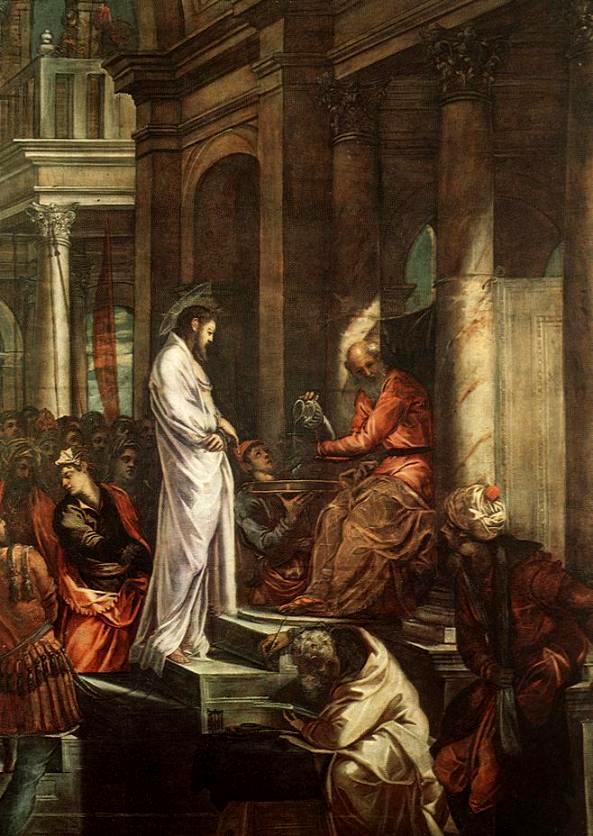24 So when Pilate saw that he could do nothing, but rather that a riot was beginning, he took some water and washed his hands before the crowd, saying, “I am innocent of this man’s blood; see to it yourselves.” [Matthew 27:24, NRSV]
Christ before Pilate, by Tintoretto, 1566.
Amongst Tintoretto’s most famous artistic compositions, Christ Before Pilate stands out as being the most popular. Three pieces of detail have always captured our imagination on the way of Jesus and the way of the world.
- First, Pilate lowering his head and looking away as he washed his hands. In avoiding eye-contact with Jesus, Pilate’s demeanour echoes his ill-conscience which his hand-washing manoeuvre sought to pacify but could not. This informs our understanding of human behaviour. So in Shakespeare’s Macbeth, after committing a regicide, Lady Macbeth’s hand-washing to get rid of blood eases not her guilt but grows into an obsessive- compulsive disorder.
- Second, whatever Pilate did, he could never escape the charge of complicity in acceding to the clamour for the illegal execution of Jesus. So the artist trains a ray of light on the pillar on which the haunting blood markings left from the scourging at the pillar are evident.
- Third, the bright ray of light centres on Jesus who, wrapped in a white mantle, stands out against the crowd and the architectural backdrop. Tintoretto is explicit about Jesus standing tall despite all the conniving to put him down, portraying Jesus standing taller than everyone else, including Pilate who, though seated on an elevated throne, appears as a reduced and diminished figure – a hypocrite, a spineless bureaucrat, and a judge who shuns the truth – a shame to his office and the so-called “power” that he had.
In his “trial” of Jesus, Pilate knew very well that an innocent man was thrust upon him. Appearing before him was Jesus, quiet and dignified in the midst of a relentless clamour for the death sentence already passed by the Jewish religious leaders. Under Roman rule and lacking the authority to punish by death, the Jewish religious leaders needed Pilate the Roman governor to hand down the death sentence and to have it instantly carried out before the Passover feast.
Repeatedly, Pilate pronounced Jesus innocent. In the meantime, his wife, Claudia, who had the truth revealed to her in a dream, had sent words to warn him against doing harm to Jesus. He attempted to have Jesus flagellated, a severe enough punishment which he hoped would pacify the vociferous crowds, and then have him released. But, the incited mob had turned relentless and mad, screaming for the release of the murderous Barabbas instead of Jesus in Pilate’s offer of a singular amnesty, while the chief priests demanded, “Crucify him!…”
After the seminar talk on the centurion and soldiers at the foot of the cross, a young professional came up and asked why Pilate agreed to have Jesus crucified despite being convinced of his innocence. The historical reality at the time was that a Roman governor was tasked to keep the peace in the region under his rule. He could lose his job, if not his life, if the people rebelled and rioted and he was unable to exercise control. Any Roman authority in Jewish territory would be on high alert during a major feast season, especially the annual Passover when the mood for riot and rebellion against a foreign power was always at its height. Pilate was already not enjoying a very good reputation in Rome at the time for past misdeeds which Rome was not pleased with. He could not afford a major incident right now. Well aware of Pilate’s weaknesses, the Jewish religious leaders relentlessly piled on the pressure:
- Manipulating the crowds;
- Inciting a malicious, vile, and vicious mob;
- Warning Pilate that he would not be a friend of Emperor Augustus if he released Jesus; and
- Threatening a civil unrest which Pilate simply could not afford.
Under immense pressure – seeing that “he was gaining nothing, but a riot was beginning,” (Matthew 27:24) – Pontius Pilate buckled and chose the easy way out to save his career. The truth of the matter is, when a careerist weighs his options, truth is often the first casualty. Hence, the public display of hand-washing to absolve himself of responsibility for the blood of an innocent man.
In delivering Jesus up to be crucified, Pilate short changed himself on truth and dignity. Yielding to religious politics, he sold his conscience in exchange for short-term gains. Such is the way of the world. But, what Pilate did not learn was that truth will never disappear. It stays within one’s heart. You can deny it, but it stubbornly lies latent until one day, you finally give it due recognition.
As Christians, we can learn from St Ambrose who taught that “man does not find the truth; man must let truth find him.” The importance of that insight was already evident to the first century B.C. Roman philosopher, Cicero, who said: “Only truth can make man happy.” Christian Scriptures go a step further. The portrait of Jesus in St John’s Gospel is one who always does what is pleasing to God the Father who sent him. And so to the Jews who believe in him, Jesus says, “If you continue in my word, you are truly my disciples, and you will know the truth, and the truth will make you free” [John 8:31-32].
Copyright © Dr. Jeffrey & Angie Goh, April 2017. All rights reserved.
You are most welcome to respond to this post. Email your comments to jeffangiegoh@gmail.com. You can also be dialogue partners in this Ephphatha Coffee-Corner Ministry by sending us questions for discussion.

